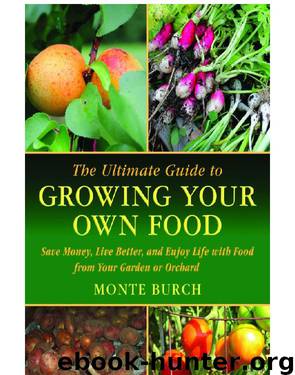The Ultimate Guide to Growing Your Own Food by Monte Burch

Author:Monte Burch
Language: eng
Format: epub
Publisher: Skyhorse Publishing, Inc.
Cucumbers are easy to grow and are a must for garnishing summer salads.
Pests. The corn earworm is the most common pest. Placing a drop of mineral oil in each ear just as it begins to tassel can help. Other pests include the following: aphids, flea beetles, cutworms, seed-corn maggots, southern corn rootworm, wireworms, fall armyworms, European corn borers, and Japanese beetles.
Harvest. Best picked at the milk stage or when a milky juice squirts out when the kernels are pierced with a thumbnail. The ears should easily snap off the stalk.
Storage: Best eaten immediately, but some varieties will store for several days, even a week or so in a refrigerator. Pressure can, freeze, or dehydrate the cut-off kernels. Dent or field corn grains can be dried on the plant and then ground into meal for storage.
***
Cucumber
Description: Cucumbers are a delightfully easy vegetable to grow, and they provide both fresh cucumbers for salads and other summer dishes, but they are also processed to produce a wide variety of pickles. Cucumbers fresh from your garden resemble nothing like the waxed kind often found in grocery stores.
Types. A wide range of varieties are available, including the popular burpless types, big, small, long, and short.
Culture
A. Propagation: direct seeded
B. Amount needed for 100-ft. row: ¼ oz.
C. Where to plant: direct sun
D. When to plant: late spring, well after frost danger
E. Row spacing: 36 in.
F. Plant spacing: 48 in.
G. Depth: ½ in.
H. How much per person: fresh, 2 to 3 hills; processed, 3 to 6 hills
I. Days from planting to eating stage: 65 to 70
Requirements
Soil type: a rich, deep soil
pH: 6.5 to 7.0
Fertilizer: a general-purpose fertilizer, chemical, or organic
Growing tips. Cucumbers need lots of water and lots of fertilizer. In most instances, cucumbers are grown in hills rather than rows, unless you’re market gardening. You’ll usually get fifteen to thirty seeds of many hybrids and one hundred or more seeds of most standard varieties in a packet. Space hills about five feet apart. Dig deep holes where the hills will be. Fill in the hole with plenty of well-rotted manure or compost. Then add about three inches of garden soil to create the hill. Place about five to six seeds to a hill. Cultivate shallowly until the vines begin to grow. Heavy mulch can prevent a lot of weeding problems, but it will take quite a bit to mulch the entire space. Cucumbers do extremely well grown on trellises or vertically, and they don’t take up nearly as much space. Growing on black plastic keeps down the weeds, but they take up a lot of garden space in this manner. My cucumber tactics have been refined over a number of years, growing them more intensively. I have a permanent trellis made from a section of cattle panel supported by steel posts and centered in a raised bed. I plant three hills on each side of the fifteen-foot panel, spacing closer than conventional spacing. As soon as the plants are up, I mulch the bed heavily. Cucumbers need lots of water as well as food.
Download
This site does not store any files on its server. We only index and link to content provided by other sites. Please contact the content providers to delete copyright contents if any and email us, we'll remove relevant links or contents immediately.
Turbulence by E. J. Noyes(7033)
The Thirst by Nesbo Jo(5779)
Gerald's Game by Stephen King(3913)
Be in a Treehouse by Pete Nelson(3207)
Marijuana Grower's Handbook by Ed Rosenthal(3114)
The Sprouting Book by Ann Wigmore(3050)
The Red Files by Lee Winter(2909)
The Remains of the Day by Kazuo Ishiguro(2614)
Sharp Objects: A Novel by Gillian Flynn(2440)
Christian (The Protectors Book 1) by L. Ann Marie(2393)
Organic Mushroom Farming and Mycoremediation by Tradd Cotter(2304)
The Culinary Herbal by Susan Belsinger(2057)
Stone Building by Kevin Gardner(1993)
The Starter Garden Handbook by Alice Mary Alvrez(1922)
Lilac Girls by Martha Hall Kelly(1868)
The Unlikely Pilgrimage of Harold Fry by Rachel Joyce(1834)
The Lean Farm Guide to Growing Vegetables: More In-Depth Lean Techniques for Efficient Organic Production by Ben Hartman(1782)
Urban Farming by Thomas Fox(1748)
Backyard Woodland by Josh VanBrakle(1586)
